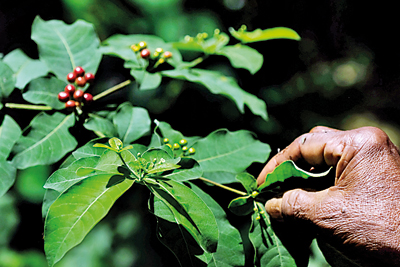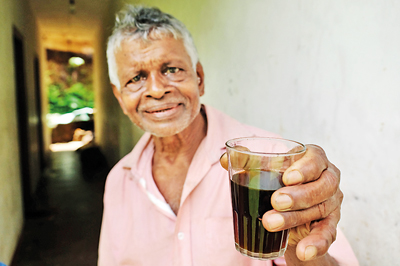Forest healer

Green and scenic: Dense rainforest
Weliwapathiranage Piyasena, 79, knows that he lives in a veritable treasure trove. His village Lankagama is surrounded by two rainforests- the Sinharaja and the Dellawa. The villagers live in dark glades which are fringes of the forest. Throughout centuries, the wisdom given by nature to the villagers has created an astounding repository of knowledge- invaluable but also now threatened and precarious.
The green crusader Norman Myers once likened the destruction of rainforests to the burning of the ancient library of Alexandria. In the case of Lankagama, the tragedy is heightened by the fact that the people who have preserved the knowledge are also dying out- and at stake is our traditional local medicine.

Sau kenda dry flowers
Lankagama had a ‘vedamahatmaya’ says Piyasena- a traditional physician who used to come from Dellawa on the other side of the forest with a chest of medicine. His rare visits alone served as medical intervention from outside. There were no trained midwives, and apothecaries were unheard of.
The inevitable void was filled by the villagers themselves- and chief amongst them Piyasena’s father Hinni-appuhamy.
“He had a knowledge that had been handed down orally,” says Piyasena, “but as he was interested in the subject he made it a point to learn more from vedamahatmayas in Kiriweldola and Pallegama villages.”
However, Piyasena laments that his father’s craft was never learnt by him systematically, though he still tends to the half-wild garden left behind- and knows most of the herbs.
Contrary to popular belief, the adaviya- the deep forest- does not yield a great variety of herbs. It is the landu-kele, the copses left after chena cultivation (slash and burn farming), that are more favoured by medicinal plants.

Ekaveriya
The children who grew up in the shadow of the forest were blessed by its bounty. A mix of Aralu (Terminaliachebula) Lunuwila (Bacopamonnieri) and sahindalunu or rock salt was part of their childhood diet, believed to ensure more brain power and strength.
During epidemics, a strip of Wada Kaha (Acoruscalamus) was worn, amulet-like, around the neck or as a bracelet on the arm- for natural properties, not magical. “Half the wadakaha bush I had outside has been taken away in the last few weeks,” Piyasena adds stoically.

Cheers: Piyasena with a herbal drink mostly of Adathoda
His voice is somewhat brittle when he recalls that “when we were young, we also did not believe much in these traditions.” A snake stone from India that his father possessed, he recalls, once astounded him with its efficacy.
Among the plants that Piyasena today deals with are wallunu, bewila, kapukinissa, eramusu, sathsanda- a soothing carpet of names that are easily garnered- at least for now- from the former chenas. But then there are plants which takes him into the deep rain forest- Wanaraja (Anoectochilus setaceus) Iruraja (Zeuxine regia) and Sandaraja- treating snake bite as well as dysuria and pains.
The very rare plants include Jatamakuta, Jatamansha (both Flickingeria macraei) and walinguru or wild ginger, while Piyasena says that wellangiriya (Paramignya monophylla) and Ankenda (Acronychia pedunculata) are also difficult to procure in his locale.
“For every ailment there is a medicine. To keep a snake bite victim alive for any amount of time, till you reach a physician, use heenaraththala (Alpiniacal carata) juice mixed with the urine of a boy under fourteen.
“Lunuwila cures epilepsy and for all phlegm diseases you can use kohomba (neem), ginger, gotukola, aralu, and valagasaal (enbiliaribes).”
Unfortunately, just as the fragile fabric of the rainforest crumbles, so does this traditional knowledge. The only hope, according to Piyasena, is that practitioners of medicine should pool their secret knowledge- guarded within families- and form a base.
“We often complain that a lot of knowledge has been purloined by the colonists from us. But what we have left is enough.Only we must get together and conserve it,” he reminds gently.




